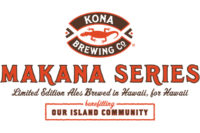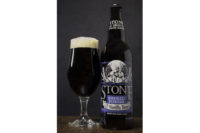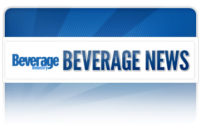2014 Craft Beer Report: Craft beer boasts fastest revenue growth of all alcohol segments
Seasonal beers could bring more female drinkers to segment



Flavored beers like radlers and shandies offer consumers a familiar flavor profile, Mintel’s Beth Bloom says. (Image courtesy of Narragansett Brewing Co.)


Earlier this year, Anheuser-Busch introduced Shock Top Honey Bourbon Cask Wheat, which features “crafty” attributes, experts note. (Image courtesy of Shock Top)





Within the past decade, the shift in consumer demand for variety and “local” beverages has resulted in a craft beer revolution in the United States. The craft segment has increased double digits in each of the past three years, despite the flat performance of the overall beer category, according to analysts. And as wine and spirits work to steal share from the beer category, craft beer has been one of its “saving graces,” says Jared Koerten, senior analyst for Euromonitor International, Chicago. In fact, the segment has been performing so well that it now represents the fastest-growing alcohol category by revenue in the United States, IBISWorld reports.
And this growth is slated to continue. The New York-based market research firm estimates that the craft beer segment will grow 16.8 percent this year and 13.5 percent next year, says Nick Petrillo, alcohol industry analyst at IBISWorld.
“The craft beer industry is expected to show continued signs of expansion through the number of facilities operated, the volume of beer produced, and the regions to which the beer is distributed,” Petrillo says.
According to the Brewers Association, Boulder, Colo., 3,040 breweries were operating in the United States as of June 30, with 1,929 breweries in planning. Ninety-nine percent of the operating breweries were small and independent craft breweries, it notes. Also in the first half of 2014, volume production of American craft beer increased 18 percent to 10.6 million barrels, it adds.
Furthermore, the association forecasts that American craft brewers will make up more than 20 percent of the market share of the beer category by 2020. Last year, the craft beer segment accounted for 14.3 percent of the dollar share and 7.8 percent of the volume share, it adds.
“Coupled with the continued rise in the number of breweries, the market growth of craft brewers highlights the ongoing localization of beer production in the United States,” said Bart Watson, chief economist at the Brewers Association, in a statement. “More and more, people are enjoying the products from America’s small and independent brewers, making this country a true destination for beer.”
Local expansion
Recently, however, the segment’s “localness” is spreading across the country as craft brewers construct secondary facilities in different regions of the United States.
“An increasing trend among craft brewers has been to construct massive facilities reaching 500,000-gallon capacities in order to brew and ship beer to other regions of the United States,” IBISWorld’s Petrillo says. “Dominant industry brewers Sierra Nevada [Brewing Co.], Lagunitas Brewing Co. and New Belgium Brewing Co. have led the charge among many large craft brewers by constructing secondary brewing facilities in different regions of the U.S.”
Sierra Nevada Brewing, based in Chico, Calif., began brewing and shipping beer from its new East Coast facility in Mills River, N.C., earlier this year. The plant boasts 230,000 square feet and operates at a full brewing capacity of approximately 350,000 barrels a year, Bill Manley, beer ambassador for Sierra Nevada, told Beverage Industry in its June issue. Similarly, Fort Collins, Colo.-based New Belgium Brewing broke ground on a 133,000-square-foot East Coast facility in Asheville, N.C., which is slated to be operational by fall 2015. Once it is up and running, the company expects to brew 500,000 barrels annually. Finally, Petaluma, Calif.-based Lagunitas Brewing opened a new facility in the Midwest this past summer. The Chicago brewery features 300,000 square feet and allows the company to expand its distribution from 36 states into all 50 states, according to a July 20 CNBC article.
These three brewers were among the Top 5 craft brewers for the 52 weeks ending Oct. 5 in U.S. supermarkets, drug stores, mass merchandisers, gas and convenience stores, military commissaries, and select club and dollar retail chains, according to data from Information Resources Inc. (IRI), Chicago. The Sierra Nevada brand family ranked No. 2, the New Belgium brand family placed third, and the Lagunitas brand family came in fifth in terms of dollar sales during the timeframe, IRI reports.
As craft beer production expands throughout the United States, it’s also spreading to other countries. The Brewers Association reports that the volume of American craft beer exports increased by 49 percent in 2013. Canada is the industry’s largest export market, with shipments increasing 92 percent by volume to 131,511 barrels in 2013. Sweden and the United Kingdom are the next two largest markets, with Australia and Japan following, it notes. In total, shipments to Asia Pacific (excluding Japan) increased by 73 percent and accounted for 44,228 barrels. Exports of American craft beer have increased substantially in the Asia-Pacific region, largely because of emerging markets such as Singapore, in which exports are up 379 percent; Hong Kong, in which exports are up 150 percent; and Thailand, in which exports are up 99 percent, it states.
“Exports of American craft beer continue to expand in the international market, reflecting craft brewing’s overall success as an industry,” said Bob Pease, who recently was appointed chief executive officer of the Brewers Association, in a statement. “New distribution agreements for U.S. breweries throughout Europe and Asia are helping to grow exports. This sustained growth is a testament to the innovation of small and independent American craft brewers and the enthusiasm of beer drinkers internationally.”
Exports of craft beer are anticipated to grow at an annualized rate of 34.8 percent in the five-year period to 2019, IBISWorld’s Petrillo adds.
Enticing new consumers
Nevertheless, craft beer’s home base remains in the United States, where it continues to battle mass domestic beers for share of stomach. Although many consumers relish craft beer for its variety and localness, the segment is challenged in that mass domestic beers typically are more “sessionable” than craft beers, Euromonitor’s Koerten says.
“One of the problems with some of the heavier craft beers, like the IPAs or the pale ales or even some of the seasonal offerings, is that they’re much heavier, so consumers generally can’t consume as much of these beers,” he explains.
In order to overcome this challenge, some craft brewers are expanding their offerings with lighter versions of their beers, Koerten notes. For instance, this past summer, Munster, Ind.-based 3 Floyds partnered with New Belgium Brewing to create Grätzer ale. The collaboration beer contained 4.5 percent alcohol by volume and 30 International Bittering Units (IBUs), making it light and sessionable despite its dark appearance, the company says.
Seasonal beers also have the ability to attract new consumers to the craft beer segment, analysts note.
“Not everybody enjoys craft beer,” IBISWorld’s Petrillo says. “In fact, many find some forms of craft beer to be too intense for their tastes. Seasonal beers are often more accessible, with fun and constantly changing flavors that really entice the massive customer class of casual craft beer drinkers.”
Plus, seasonal beers can help bring more female consumers into the craft beer segment, he notes. Approximately 58 percent of beer drinkers are male, and 42 percent are female, but women’s consumption is increasing, he says.
“The share of women beer drinkers has increased gradually during the past five years and is anticipated to continue over the next five years thanks to the increased marketing and availability of certain seasonal craft beers, which typically perform well among female consumers,” Petrillo explains.
Limited-edition, seasonal beers also give consumers something special to look forward to throughout the year, Euromonitor’s Koerten adds. According to IBISWorld data, seasonal beers are the second-most popular craft beer style with a 23.7 percent share of the segment. The No. 1 style is IPA with a 25.2 percent share, it states.
Another format that can help incorporate new consumers into the craft beer segment is variety packs, Euromonitor’s Koerten says. The popularity of this packaging format falls in line with the craft beer segment’s primary consumer: millennials.
“This group is very much into individualism, into being unique, being different and standing out, and craft beer allows them to drink something that’s very different than what their parents or grandparents drank … and allows them to express themselves, their own tastes, and their own identity,” he says.
These younger consumers of legal drinking age also enjoy trying new things, adds Beth Bloom, food and drink analyst at Mintel, Chicago. According to the market research firm’s June 2014 “Craft Beer – US” report, 44 percent of surveyed drinkers say it is a source of pride to try as many different kinds of beer as they can. This gives a badge value or discovery factor to craft beers, she notes.
Taking trial to the next level, Sierra Nevada partnered with 12 other craft brewers to make a mixed 12-pack for its Beer Camp Across America tour this past summer. Collaboration, which is somewhat unique in the craft beer segment, also enables craft brewers to expand the reach of the segment, Bloom adds.
Additionally, familiar flavors are trending in the craft beer market and drawing consumers into the segment, she notes.
“There’s been this move to expand flavor offerings, so we’re seeing these radlers or shandies, which we’re seeing in the mainstream market too, where you get these fruit flavors added to beers to appeal to people who want a sweeter drink or a more familiar flavor — less harsh, less bitter, less robust,” Bloom explains.
For instance, Providence, R.I.-based Narragansett Brewing Co. collaborated with Cranston, R.I.-based Del’s for the limited-edition summer release of Narragansett Del’s Shandy. The beer combines Narragansett lager and Del’s tart lemon concentrate.
Fruit flavors like raspberry and strawberry also have become more popular among some of the smaller craft brewers to appeal to a wider consumer group, Euromonitor’s Koerten adds.
Furthermore, sour beers are gaining interest, Mintel’s Bloom notes. Nielsen, New York, affirms this trend. Sour beers are on trend with the popularity of natural, organic and unprocessed foods and beverages, the market research firm says. It adds that demand is high for sour beers because they are difficult to make and expensive.
Also playing off of this trend, cask beer could become a popular form of craft beer in the next five years because of its perceived authenticity, IBISWorld’s Petrillo says. Cask beer is unfiltered and unpasteurized beer that is served through non-pressurized casks instead of carbon-dioxide- or nitrogen-filled kegs, he explains.
Nielsen also predicts the comeback of smoked beers, in which malts are smoked over an open flame before brewing. These beers feature a full body, intense flavor and high alcohol content, the company says.
At the end of October, San Diego-based Stone Brewing Co. introduced its Stone Smoked Porter with Chocolate & Orange Peel, which is a limited-edition take on its year-round Stone Smoked Porter. The beer features peat-smoked malt, 5.9 percent alcohol by volume and 53 IBUs.
Premium positioning
As craft brewers work to deliver a wide range of beers to meet various consumer demands and interests, they typically issue a higher price point to accommodate the quality ingredients they’re using. Luckily, the craft beer segment mirrors the wine and spirits categories in which consumers are trading up to more premium offerings, Euromonitor’s Koerten says.
Donna Hood Crecca, senior director at Chicago-based Technomic Inc., affirms this trend, saying in a statement: “The core mainstream domestic beer consumer that was impacted by the recession remains somewhat challenged, so value beer is suffering. At the same time, many consumers are trading up to higher-priced craft, imported and super-premium beers. The result is a decline at the lower price tiers and growth at the high end.”
This premium positioning also carries over into gifting, as the majority (53 percent) of consumers said that it is just as appropriate to bring beer as a host or housewarming gift as it is to bring wine, Mintel’s Bloom says. Whereas craft beer was more of a casual beverage to drink during sports games in the past, it’s now being elevated to the level of wine, where it is a gift-worthy product and can be paired with meals, she adds.
Brewing Big
In the future, craft beer will continue to face competition from the mass domestic brewers, which make up the majority of the beer market, but not necessarily from their flagship brands. Instead, their “crafty” offerings will more aggressively compete with craft beer brands, according to analysts. For instance, many of the major beer players have acquired successful craft brands in order to compete in the craft beer space, Euromonitor’s Koerten notes. Such acquisitions technically take the “craft” designation away from the brewers, based on the Brewers Association’s definition of craft beer. The association states that less than 25 percent of a craft brewery can be owned or controlled by a non-craft brewer, annual production must equate to 6 million barrels or fewer, and the majority of its total beverage alcohol volume must come from beers whose flavor derives from traditional or innovative brewing ingredients and their fermentation. Nevertheless, acquiring craft brewers or launching craft-like beers enables large brewers to more directly compete against craft beers. This could slow the growth of craft beer in the future, according to Mintel’s Bloom.
“Now that you have some of these mainstream brands picking up craft attributes, consumers might be turning back to more readily available, lower-price-point products,” she says.
For instance, earlier this year St. Louis-based Anheuser-Busch launched Shock Top Honey Bourbon Cask Wheat, which features craft beer attributes. The year-round offering is a Belgian-style unfiltered wheat ale brewed with honey and caramel malt and aged on bourbon cask staves. Many of the large brewers also release limited-edition or seasonal beers, just as the craft brewers do, IBISWorld’s Petrillo adds. For example, Chicago-based MillerCoors offers its “crafty” Blue Moon brand in various seasonal and limited-edition flavors.
“The popularity of non-craft brewers’ limited-edition flavors is likely to increase over the next five years, which may actually hamper the craft beer production industry’s profitability in the years to 2019,” he says.
Despite these challenges, Mintel expects the craft beer segment to increase double-digits for the next five years. Growth within the segment will still be strong but smaller than what the industry has seen to date, Bloom says.
Crafty packaging
Six- and 12-packs account for 90 percent of craft beer case volume, but other package sizes are on the rise, according to Andrea Riberi, senior vice president of New York-based Nielsen. In particular, 16- and 22-ounce bottles accounted for 5 percent of craft beer sales but represented 9 percent of growth in the 52 weeks ending Oct. 18 in Nielsen-measured outlets, she notes. Additionally, four-packs accounted for only 2 percent of volume but contributed 9 percent of growth, she says. Most significantly, glass bottles still make up the vast majority of the craft beer segment, but cans have grown 28 percent in the timeframe, she adds.
Cans are a practical choice because, generally, they are easier to ship, store and distribute on a large scale compared with glass bottles, says Jared Koerten, senior analyst with Euromonitor International, Chicago.
“There is a lot of talk in the industry around craft beer getting into cans,” he says. “It’s still very, very small, but it is something that could be on the horizon with a shift into cans.”
Looking for a reprint of this article?
From high-res PDFs to custom plaques, order your copy today!











